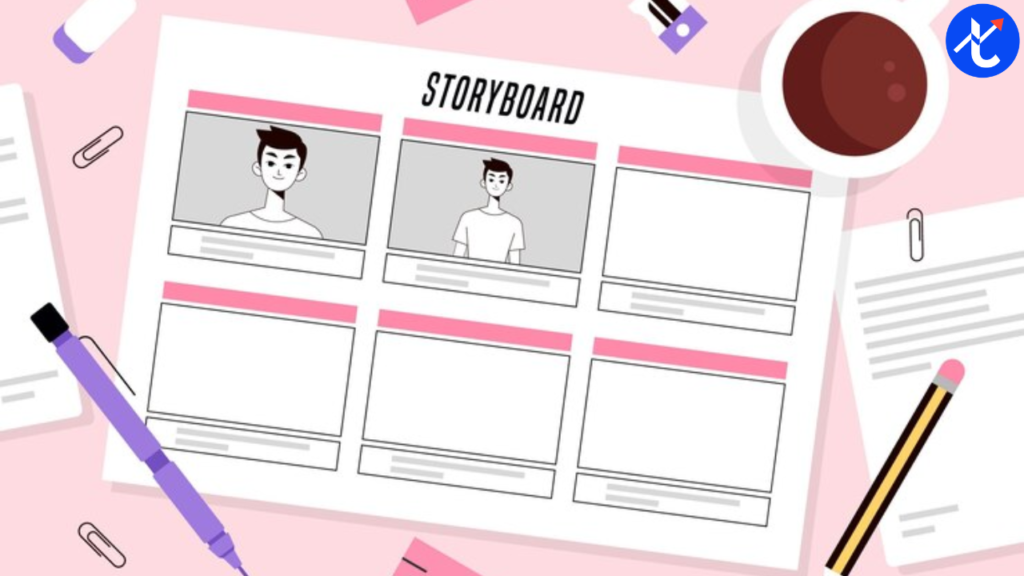Storyboarding has become an essential tool for creators to visualize and plan their ideas effectively. Whether you’re an animator, educator, or marketer, storyboards provide a structured framework for outlining concepts. For those on a tight budget, free storyboarding software offers robust functionality, ensuring creators can bring their visions to life without any financial barriers.
What is Free Storyboarding Software?
Free storyboarding software enables users to create professional-quality storyboards without cost. These tools often come equipped with user-friendly interfaces, pre-designed templates, and advanced features like cloud collaboration. They cater to diverse users, from students and educators to content creators, allowing them to turn their ideas into compelling visual plans.
Why Use Free Storyboarding Software?
1. Simplified Creative Process
Free storyboarding software revolutionizes the way creators visualize and organize their projects. By offering intuitive interfaces, these tools enable users to turn abstract ideas into structured visual plans. Key features like drag-and-drop functionality, pre-built templates, and customizability reduce the time and effort needed for setup, allowing creators to focus on refining their stories. Moreover, such software often includes tools for annotating, layering, and arranging sequences, which ensures every detail is captured clearly. Whether you’re outlining a complex narrative or mapping a marketing campaign, these features enhance clarity and efficiency in your workflow.
2. Enhanced Collaboration
Collaboration is crucial in today’s interconnected work environments, and free storyboarding tools excel in this area. Many platforms are cloud-based, allowing team members to access and edit projects simultaneously from different locations. This real-time collaboration eliminates the need for lengthy email threads and file transfers, ensuring everyone stays on the same page. Advanced features such as version control, comment systems, and role-based permissions further enhance teamwork, making it easier to brainstorm, review, and refine projects collectively. For global teams or projects with tight deadlines, these capabilities streamline communication and boost productivity.
3. Ideal for Beginners and Budget-Conscious Creators
For students, educators, startups, and small businesses, financial constraints often limit access to premium software. Free storyboarding tools level the playing field by providing essential functionalities at no cost. These tools cater to users with varying skill levels, offering tutorials, user-friendly interfaces, and drag-and-drop capabilities to minimize the learning curve. Beginners can start creating professional-quality storyboards without the pressure of investing in expensive software, while seasoned creators can use free platforms as supplemental tools for quick drafts or collaborative tasks. This accessibility empowers creators to bring their visions to life, regardless of budget limitations.
Key Features of Free Storyboarding Software
1. Drag-and-Drop Interface
A hallmark feature of free storyboarding software is its intuitive drag-and-drop interface. This user-friendly design eliminates the need for advanced technical skills, allowing even beginners to create professional-quality storyboards effortlessly. With simple gestures, users can add, rearrange, or delete elements like characters, backgrounds, or text. This functionality not only speeds up the creation process but also ensures that ideas can be quickly visualized and adjusted without complicated commands.
2. Pre-designed Templates
Free storyboarding tools often come with a library of professionally designed templates, tailored for various industries and purposes. Whether you’re creating a lesson plan, a social media campaign, or a narrative outline, these templates provide a strong foundation to build upon. They save time and help maintain consistency in design. Users can choose from styles suited for animations, marketing, education, or gaming, ensuring their project looks polished and relevant from the start.
3. Export Options
Sharing and presenting your work is made easy with versatile export options. Free storyboarding software typically supports multiple formats, such as PNG, JPEG, PDF, or even PowerPoint, depending on the platform. This allows creators to adapt their outputs to suit different needs, like client presentations, team collaborations, or printing. Some tools even offer high-resolution export capabilities, ensuring that the quality of your visuals is preserved for professional use.
4. Cloud Integration
Many free storyboarding platforms are cloud-based, providing seamless access to projects from any device with an internet connection. This feature is invaluable for creators who work across multiple devices or need to collaborate with remote team members. Cloud integration also ensures that your projects are automatically saved and backed up, reducing the risk of losing valuable work. Additionally, updates made in real-time allow for synchronized teamwork and efficient project management.
5. Customizable Tools
Free storyboarding software often includes an array of customization options, allowing creators to tailor their projects to meet specific requirements. Users can adjust fonts, colors, shapes, and sizes, or even import custom assets to align with branding guidelines or creative visions. Advanced customization features may also include animation effects, transitions, and scene editing tools, providing flexibility and creative control over every aspect of the storyboard.
Best Free Storyboarding Software Options
1. Storyboarder by Wonder Unit
- Overview: Storyboarder is an open-source storyboarding platform designed for simplicity and speed. Its minimalist interface allows creators to focus on visualizing their ideas without getting overwhelmed by unnecessary features.
- Key Features:
- Quick sketching tools that support drawing with a mouse, tablet, or imported images.
- Scene timing adjustments to help visualize pacing.
- Integration with professional software like Photoshop for advanced editing.
- Export options in various formats, including GIF and PDF.
- Quick sketching tools that support drawing with a mouse, tablet, or imported images.
- Best For: Filmmakers, animators, and creators who need a free, lightweight tool for rapid idea generation and visualization.
2. Canva Storyboards
- Overview: Canva is a versatile design platform that excels in creating visually appealing storyboards for marketers, educators, and general creators. Its drag-and-drop editor is ideal for users of all skill levels.
- Key Features:
- A vast library of professionally designed templates tailored for different needs.
- Access to millions of stock images, icons, and elements to enhance storyboards.
- Easy sharing and collaboration features, including links and team comments.
- Compatibility with desktop and mobile devices for on-the-go editing.
- A vast library of professionally designed templates tailored for different needs.
- Best For: Marketers, educators, and designers looking for visually polished storyboards with minimal effort.
3. Boords
- Overview: Boords is a web-based storyboarding platform that prioritizes collaboration and organization. It’s particularly suited for teams working on creative projects.
- Key Features:
- Scene templates and shot organization tools for streamlined workflows.
- Built-in note-taking for each scene to document ideas and instructions.
- Version history to track changes and revert to previous iterations.
- Export options to PDF or animatics for presentations or client reviews.
- Scene templates and shot organization tools for streamlined workflows.
- Best For: Creative teams that require robust collaboration and version control for their projects.
4. Plot
- Overview: Plot is a storyboarding tool tailored for writers and storytellers. It focuses on narrative-building, making it a go-to choice for those crafting detailed stories.
- Key Features:
- Tools for structuring character arcs and narrative sequences.
- Scene categorization for organizing complex storylines.
- Simple interface designed to focus on storytelling without distractions.
- Export and sharing options for presenting polished narratives.
- Tools for structuring character arcs and narrative sequences.
- Best For: Writers, novelists, and narrative designers who want to organize story ideas visually.
5. StudioBinder
- Overview: StudioBinder is a comprehensive pre-production suite that includes a professional-grade storyboarding tool. Its wide array of features caters to complex, high-level projects.
- Key Features:
- Customizable storyboards with detailed shot descriptions, camera movements, and scene settings.
- Cloud-based collaboration for teams to work on projects in real-time.
- Integration with other pre-production tools like shot lists and schedules.
- High-quality exports for professional presentations.
- Customizable storyboards with detailed shot descriptions, camera movements, and scene settings.
- Best For: Professional teams and individuals managing large-scale creative projects that require detailed planning.
Which Tool is Right for You?
- For Quick Sketching and Simplicity: Storyboarder by Wonder Unit.
- For Visual Appeal and Versatility: Canva Storyboards.
- For Team Collaboration: Boords.
- For Narrative Focus: Plot.
- For Professional Pre-Production: StudioBinder.
Uses for Free Storyboarding Tools
Content Marketing
Marketers can map out visual campaigns, social media strategies, and video advertisements using storyboarding software, ensuring clear and consistent messaging.
Education
Teachers and students benefit from storyboards to create interactive lessons, visual essays, and multimedia projects.
Game Development
Game developers use storyboards to design narrative structures, character movements, and immersive environments.
Pricing and Limitations of Free Storyboarding Software
While free storyboarding tools provide cost-effective solutions, they often come with certain trade-offs that users should consider. Understanding these limitations can help you choose the best platform for your needs.
Common Limitations of Free Storyboarding Software
- Limited Features
- Free plans typically include only the essential functionalities, which may not be sufficient for advanced projects.
- Features like high-resolution exports, custom branding, advanced editing tools, or integration with other professional software (e.g., Photoshop, Premiere Pro) often require a paid subscription.
- Animatics or advanced motion tools may be absent in free versions, limiting their use for detailed projects.
- Free plans typically include only the essential functionalities, which may not be sufficient for advanced projects.
- Watermarks
- Some free storyboarding platforms include their branding or watermarks on exported files, which can be unprofessional for client presentations or public sharing.
- Upgrading to a premium plan is usually necessary to remove these watermarks.
- Some free storyboarding platforms include their branding or watermarks on exported files, which can be unprofessional for client presentations or public sharing.
- Storage Restrictions
- Free plans often impose limits on cloud storage, capping the number of storyboards you can save.
- Frequent users may need to delete older projects or purchase additional storage to continue using the platform effectively.
- Free plans often impose limits on cloud storage, capping the number of storyboards you can save.
- Collaboration and Team Features
- Many free tools offer limited or no collaboration features, which can hinder team projects.
- Advanced collaboration tools, such as real-time editing, version history, or user roles, are typically available only in premium versions.
- Many free tools offer limited or no collaboration features, which can hinder team projects.
Examples of Pricing and Limitations for Popular Free Tools
- Boords Free Plan
- Limitations:
- Allows up to three storyboards per month.
- Advanced features like unlimited storyboards, animatics, and branding removal require a paid subscription.
- Limited access to collaboration tools.
- Upgrade Options:
- Paid plans start at approximately $29 per month for enhanced features and unlimited storyboards.
- Paid plans start at approximately $29 per month for enhanced features and unlimited storyboards.
- Limitations:
- Storyboarder by Wonder Unit
- Limitations:
- Fully free and open-source, but lacks advanced features like polished design templates or motion effects.
- No built-in collaboration tools or cloud storage; projects are stored locally unless manually synced via third-party services.
- Fully free and open-source, but lacks advanced features like polished design templates or motion effects.
- Strengths:
- No watermarks or hidden costs, making it ideal for personal and small-scale projects.
- No watermarks or hidden costs, making it ideal for personal and small-scale projects.
- Limitations:
- StudioBinder Free Plan
- Limitations:
- Free users have access to limited pre-production tools and storage.
- Certain features, like shot lists and detailed customization, are restricted to premium tiers.
- Free users have access to limited pre-production tools and storage.
- Upgrade Options:
- Premium plans start at around $29 per month, unlocking additional features like team collaboration and unlimited projects.
- Limitations:
- Canva
- Limitations:
- Free access includes a limited number of templates and design elements.
- Premium assets, fonts, and advanced features like transparent exports require a Canva Pro subscription.
- Free access includes a limited number of templates and design elements.
- Upgrade Options:
- Canva Pro starts at $12.99 per month for individuals, offering a vast library of premium resources and no watermarks
- Canva Pro starts at $12.99 per month for individuals, offering a vast library of premium resources and no watermarks
- Limitations:
- Plot
- Limitations:
- Free tier may limit the number of projects or access to narrative structuring tools.
- Free tier may limit the number of projects or access to narrative structuring tools.
- Upgrade Options:
- Pricing typically starts at $10–$15 per month for expanded features like cloud storage and collaboration.
- Limitations:
Tips to Maximize Free Plans
- Choose Tools Wisely: Evaluate your needs and select software that offers the most relevant features in its free tier.
- Combine Platforms: Use multiple free tools to cover different aspects of your project. For example, start with Storyboarder for sketching and use Canva for polished designs.
- Optimize Storage: Regularly back up and delete older projects to make the most of limited storage allowances.
- Upgrade Strategically: If you find yourself outgrowing a free plan, consider upgrading only when the additional features justify the cost.
Wrap-Up
- Free storyboarding software is a versatile and accessible resource for creators in various fields.
- These tools are ideal for content marketing, education, and game development projects.
- While free options may have limitations, they provide a fantastic starting point for beginners and budget-conscious users.
By using free storyboarding software, creators can focus on their vision, collaborate with teams, and present polished, professional results without spending a dime. Whether you’re designing a lesson, planning a campaign, or building the next big game, these tools are your gateway to effortless creativity.





